An "Artistic" Tour of Singapore
For this entry I am going to give a little virtual tour of Singapore. Instead of photos that I have taken, I thought that I would try an approach that was a little bit different. I found a set of small pictures of various city scenes. I selected some that showed places in the city that we have come to know in the two months or so that we have been here. It is by no means a complete tour. But I think it provides a different view than the usual photos.
Orchard Road
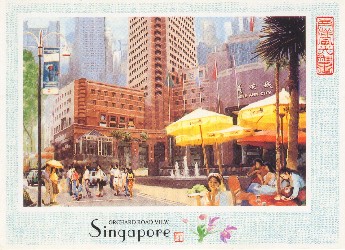 One of the more impressive sections of Orchard Road.
One of the more impressive sections of Orchard Road.
Orchard Road is the main shopping street in Singapore. It is lined from one end to the other with hotels and shopping centers. It is always filled with people. In some portions of Orchard Road, the sidewalk is over twenty five feet wide. And during the day and most of the evening, it is crowded! The shopping centers here are all built up rather than out. They might be five to eight stories tall. So they are packed quite close together and you might have three major shopping centers in one city block. Some of them are actually quite complex inside, and it is impossible to learn your way around them or to know all of the stores in them. Besides that, there are a number of underground tunnels that cross streets, connect shopping centers or serve as MRT (subway) stations. You need to know your way around in three dimensions, not just two.
Orchard Road is the neighborhood we live in. Our apartment building is two blocks off of Orchard Road. Every day I walk down to Orchard Road, usually multiple times. That's where I go for every kind of shopping: groceries, household items, books, etc. I also head down there to go to the Post Office, the bank, dry cleaners and various other types of services. It is also one of the few streets that goes through in the direction it runs (a funny northwest to southeast slant, but hey, that's how Singapore is layed out). So anywhere that you want to go from our house, you pretty much take Orchard Road. Everything else is blocked by expressways and divided highways, large buildings, hills, or streets that just don't go through. In the evening we frequently walk along Orchard road to find a restaraunt. There are a lot of really nice restaraunts that have patio seating. It is always really pleasant to sit out in the evening and have dinner and a drink (ok, maybe a couple of drinks) and watch the endless parade of people.
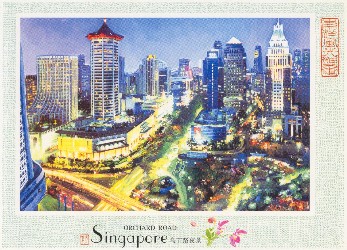 Orchard and Scotts Road
Orchard and Scotts Road
The shopping centers along Orchard Road are truely amazing. On one side of the street you have Lucky Plaza, which is jam packed with tiny shops selling tshirts, tacky souvenirs, every kind of electronics you can imagine (digital cameras, cell phones, camcorders, xboxes and games), watches, tailor shops. It really is a zoo. Then across the street is Takashimaya Shopping Center, with it's fancy fountains at the entrance (see the first picture) and every designer store in the universe. They probably have three or four Armani shops alone. That's not even counting Cartier, Gucci, Prada and Polo. Needless to say, Sandy and Shannon are at Takashimaya a lot, and I'm at Lucky Plaza most of the time.
Singapore River
The area along the Singapore River is the heart of the city. It is a really nice area, very scenic and with lots of interesting sights and a lot of nice restaraunts and bars. There is a nice walkway on both sides of the river. There are river taxis that are old-fashioned Chinese bumboats. Until 150 years ago, the port area of Singapore was along the river. That didn't change until the mid-nineteenth century when steam ships became common and a deep water port was created. But the bumboats will still pick you up and drop you off at a number of points along the river. Most people just ride them to get a tour of the river front, Marina Bay and the Merlion.
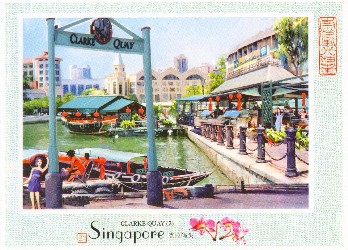 Clarke Quay along the Singapore River
Clarke Quay along the Singapore River
Clarke Quay is the beginning of the developed area along the river. It is the newest developed area. It does have some nice restaraunts. But it is also controversial. The buildings along the river are painted in bright colors. The walkways between the buildings are covered by a high-tech type of tent structure. A lot of people think it looks gaudy and tacky. I kind of agree - my own opinion is that it looks way too touristy. We may go there for dinner sometimes, but it isn't my favorite spot on the river. It does have the reverse bungy ride. It's a thrill ride that shoots people up into the air about 150 feet in a small chair. Shannon, after her bungy adventure in New Zealand, is looking for new challenges and is anxious to get Mickey to do this ride with her when he comes at spring break. I'll report on what happens during his visit. Unfortunately, the seat holds three people, so I will probably be invited to go along. Sandy has already volunteered to be the official photographer. You can learn more at the official G-Max website. Clarke Quay also has a Hooters restaraunt, probably one of the few places in town to get a good Singapore souvenir tshirt. (Hard Rock cafe also has good tshirts.) Most of the local tshirts are pretty poor quality.
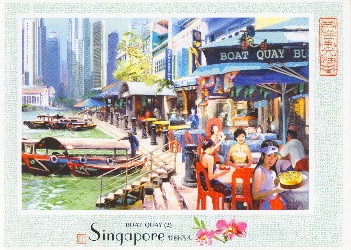 Boat Quay - my favorite section along the river
Boat Quay - my favorite section along the river
Next along the river after Clarke Quay is Boat Quay. It's about two blocks downriver on the opposite side. It is a solid line of restaraunts that extends along the riverside for two blocks. All the restaraunts have patio seating right along the waterfront. Since people in Singapore tend to eat dinner later in the evening, we usually go early (6:00 to 6:30 qualifies as early). We have our pick of any of the places along the river and can usually get seating right by the water. Walking along the quay, especially early in the evening when the restaraunts are empty, does feel a little like running a gauntlet. Every place has someone out in front to try to entice customers into the restaraunt. "Some dinner, sir? Take a look, sir?" Whatever you do - don't make eye contact!
There must be every kind of cuisine along Boat Quay. There is seafood, italian, french, thai, indian, indonesian, middle eastern, and some that I am not even sure of. An interesting restaraunt which we have tried is the "Sizzling Rock". Your meat or fish dinner is served on a thick rock plate which has been heated to a very high temperature. You watch it cook right in front of you from the heat of the plate. It's fun. All of the places along Boat Quay have a really pleasant view of the river. Most of the customers are either tourists or people who work in the central business district which is right behind Boat Quay. Later in the evening there are a couple of bars along the end of the quay that are so packed on weekends that it is hard to walk past them through all the people overflowing onto the street.
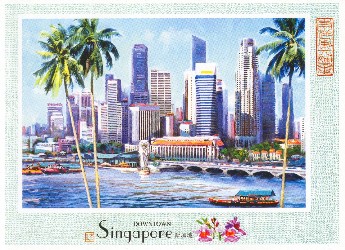 Central Business District
Central Business District
Behind Boat Quay is the Central Business District. This is the largest collection of tall buildings in the city. It presents a very attractive skyline from the other side of the river. This is the view shown in the picture. We also have a spectacular view of the CBD from the patio of our apartment. We are on the twelfth floor and have a clear view of all of the skyscrapers in the financial district. There are several buildings that are 70 stories tall - the height limit for buildings in Singapore being 240 meters. Sandy and I often have a glass of wine on our patio and admire the view. It is impressive during the day, or when the buildings are lit up at night. All of the buildings are quite new, as the growth in Singapore has been remarkable during the last 40 years. The country has moved from being a third world asian country to being first world in only four decades. The standard of living has grown 400% in that time. So almost everything here is new.
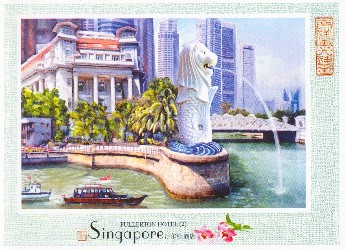 The Merlion - Singapore's tourist symbol
The Merlion - Singapore's tourist symbol
Past the Central Business District is one of the main landmarks of Singapore - the Merlion. Singapore is known as the Lion City. The name in Malay is Singapura, which literally means "lion city". Back in the seventies, the Singapore Tourism Board came up with the Merlion as a symbol for the city, combining the head of a lion from the historic name with the body of a fish representing the port of Singapore. It has become a major attraction for tourists, although a lot of native Singaporians aren't too crazy about a national symbol generated for a tourist marketing campaign. All of the boats riding up and down the river swing by the Merlion statue and everyone takes photographs. Tshirts and tiny statues of the Merlion are sold all over town. Behind the statue is the historic building of the Fullerton Hotel, which dates back to the British Colonial days of the nineteenth century. Besides the Merlion along the river, there is also a large statue of the Merlion on a hill on Sentosa Island, a tourist area just off of the main island of Singapore.
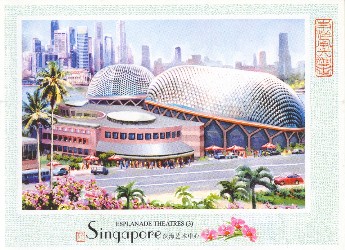 Esplanade Theatres
Esplanade Theatres
Finally, across from the Merlion statue are the Esplanade Theatres. They are very distinctive buildings. The first time I saw them I thought of the Sydney Opera House. Not the same kind of design, but unconventional. There have quite a few concert and theatre performances there but we haven't been to an event there yet. But the buildings are very distinctive in appearance and impossible not to notice as you walk down the river. The buildings are basically huge glass domes. Their unique appearance is accentuated by metal shades which cover the glass to prevent them from overheating from the greenhouse effect in the tropical sun. They are jokingly referred to "The Durians" (durian is a tropical fruit with a spiky skin). There is a great view of the CBD from the bridge that crosses the river from the Esplanade to the Fullerton Hotel and Merlion.
Other areas
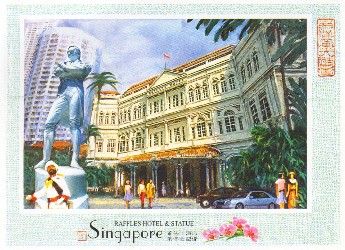 Raffles Hotel
Raffles Hotel
Between the river and the end of Orchard Road is the Raffles Hotel. This hotel also dates back to the nineteenth century. It is named for Sir Stamford Raffles, the British naval officer who first came to Singapore in the early eighteen hundreds and worked to have it become a British colony (it actuall took some convincing - the British did not want it as a colony at first). At that time there was just a small run down fishing village/port and virtually no government or control. It didn't really take off as a deep water port until 1869 when the Suez Canal was completed. That put it on the main shipping routes between Europe and Asia. Today it is still the busiest port in the world. Seventeen percent of all shipping traffic in the world goes through Singapore. I always find that statistic amazing. Everywhere you go in Singapore there are things named after Stamford Raffles: Stamford Road, Raffles Center, Raffles Place, etc. The Raffles Hotel is probaly most famous for it's main bar, where the Singapore Sling was invented around 1910. I suppose one of these days we will have to go down there and have an overpriced drink (a Singapore Sling, of course) just for the sake of history.
Near the Raffles Hotel is the Raffles Center. It has, you guessed it, another big shopping center. It also has two hotels. One of them, the Swisshotel, is a seventy story tower. It has a restaraunt and bar on the top floors. It's where we went to celebrate Shannon's sixteenth birthday. Because it is isolated from any other really tall buildings, it has a spectacular view. You can see south across the straights to Indonesia, across the river to the CBD, out across most of the city and pretty much the whole island of Singapore. We could even see our apartment building, which is not visible from very many points in the city.
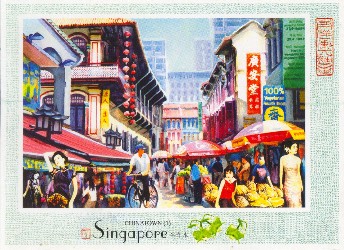 Chinatown
Chinatown
The last area on the Pictures of Singapore Tour is Chinatown. It is set back from the river north of the CBD and Boat Quay. Years ago there were many small shops run by the Chinese in Singapore that were clustered in this area. Today there are still a couple of streets centered on Pagoda Street that are lined with small shops and street merchants. When we went there on a Saturday afternoon a few weeks ago Sandy found a lot of clothes there that she liked, things that were nice but have a distinctly asian look. She has been gradually shifting her wardrobe since we got here.
There are also quite a few places to eat in Chinatown. It's the best place to go for, surprise, Chinese food. But even Chinatown is a classic Singaporean mixture. Right at the entrance to Pagoda Street is a large temple, but it's a Hindu temple. At Chinese New Year Chinatown had the most elaborate decorations of any part of the city.
